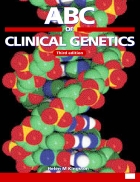Product Description
This ABC is a concise, highly illustrated introduction to genetic mechanisms involved in inherited disorders. The new edition has been extensively updated with new and revised chapters to encompass rapid advances in the field. Basic genetic concepts are explained along with the application of new technologies in clinical practice. Information on relevant web sites are also included along with recommended texts for further reading.
Preface
Since the first edition of this book in 1989 there have been enormous changes in clinical genetics, reflecting the knowledge generated from the tremendous advances in molecular biology, culminating in the publication of the first draft of the human genome sequence in 2001, and the dissemination of information via the internet. The principles of genetic assessment and the aims of genetic counselling have not changed, but the classification of genetic disease and the practice of clinical genetics has been significantly altered by this new knowledge. To interpret all the information now available it is necessary to understand the basic principles of inheritance and its chromosomal and molecular basis. Recent advances in medical genetics have had a considerable impact on other specialties, providing a new range of molecular diagnostic tests applicable to many branches of medicine, and more patients are presenting to their general practitioners with concerns about a family history of disorders such as cancer. Increasingly, other specialties are involved in the genetic aspects of the conditions they treat and need to provide information about enetic risk, undertake genetic testing and provide appropriate counselling. All medical students, irrespective of their eventual career choice therefore need to be familiar with genetic principles, both scientific and clinical, and to be aware of the ethical implications of genetic technologies that enable manipulation of the human genome that may have
future application in areas such as gene therapy of human cloning. The aim of this third edition of the ABC is therefore to provide an introduction to the various aspects of medical genetics for medical students, clinicians, nurses and allied professionals who are not working within the field of genetics, to generate an interest in the subject and to guide readers in the direction of further, more detailed information.
In producing this edition, the chapters on molecular genetics and its application to clinical practice have been completely re-written, bringing the reader up to date with current molecular genetic techniques and tests as they are applied to inherited disorders. An introduction to the internet in human genetics has also been included. There are new chapters on genetic services, genetic assessment and genetic counselling together with a new chapter highlighting the clinical and genetic aspects of some of the more common single gene disorders. Substantial alterations have been made to most other chapters so that they reflect current practice and knowledge, although some sections of the previous edition remain. A glossary of terms is included for readers who are not familiar with genetic terminology, a further reading list is incorporated and a list of websites included to enable access to data that is changing on a daily basis. As in previous editions, illustrations are a crucial component of the book, helping to present complex genetic mechanisms in an easily understood manner, providing photographs of clinical disorders, tabulating genetic diseases too numerous to be discussed individually in the text and showing the actual results of cytogenetic and molecular tests.
I am grateful to many colleagues who have helped me in producing this edition of the ABC. In particular, I am indebted to Dr David Gokhale who has re-written chapters 17, 18 and 20, and has provided the majority of the illustrations for chapters 16, 17 and 18. I am also grateful to Lauren Kerzin-Storrar and Tara Clancy for writing chapter 3 and to Dr Bronwyn Kerr for contributing to chapter 11. Numerous colleagues have provided illustrations and are acknowledged throughout the book. In particular, I would like to thank Professor Dian Donnai, Dr Lorraine Gaunt and Dr Sylvia Rimmer who have provided many illustrations for this as well as previous editions, and to Helena Elliott who has prepared most of the cytogenetic pictures incorporated into this new edition. I am also very grateful to the families who allowed me to publish the clinical photographs that are included in this book to aid syndrome recognition.
Product Details
Paperback: 120 pages
Publisher: BMJ Books; 3 edition (February 28, 2002)
Language: English
ISBN-10: 0727916270
ISBN-13: 978-0727916273
Product Dimensions: 11.6 x 8.2 x 0.4 inches





 ABC of Clinical Genetics 3rd Edition
Product Description This ABC is a concise, highly illustrated introduction to genetic mechanisms involved in inherited disorders. The new edition has been extensively updated with new and revised chapters to encompass rapid advances in the field.
pdf Đăng bởi
nangvang_anhvaem
ABC of Clinical Genetics 3rd Edition
Product Description This ABC is a concise, highly illustrated introduction to genetic mechanisms involved in inherited disorders. The new edition has been extensively updated with new and revised chapters to encompass rapid advances in the field.
pdf Đăng bởi
nangvang_anhvaem